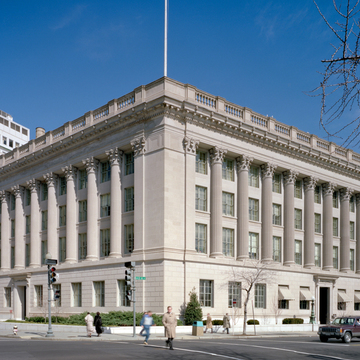This building was originally planned to extend the entire length of Madison Place. Following the scheme suggested by the McMillan Commission and stimulated by Robert Mills's east facade of the Treasury Building, Gilbert planned to frame the entire square with an almost continuous colonnade. Built of Indiana limestone, the Treasury Annex's two identical facades consist of rusticated basements set behind retaining walls and a giant Ionic colonnade framing three stories lit by floor-to-ceiling windows. The deep entablature masks a skylit story, and a recessed attic is partially obscured by the balustrade. This arrangement was a typical Beaux-Arts solution for minor urban office buildings that were meant to provide a contextual visual support for their more important and monumental neighbors. Instead of copying the style of the Ionic of the Erechtheum as it was used in the Treasury Building, Gilbert chose that of the Temple on the Ilissus in Athens, thus maintaining simple Greek lines but varying the details.
You are here
Treasury Annex
If SAH Archipedia has been useful to you, please consider supporting it.
SAH Archipedia tells the story of the United States through its buildings, landscapes, and cities. This freely available resource empowers the public with authoritative knowledge that deepens their understanding and appreciation of the built environment. But the Society of Architectural Historians, which created SAH Archipedia with University of Virginia Press, needs your support to maintain the high-caliber research, writing, photography, cartography, editing, design, and programming that make SAH Archipedia a trusted online resource available to all who value the history of place, heritage tourism, and learning.

